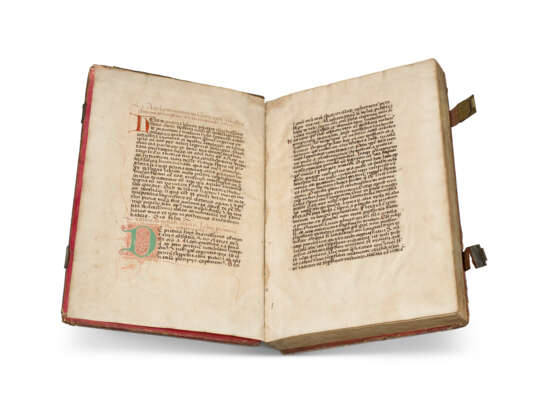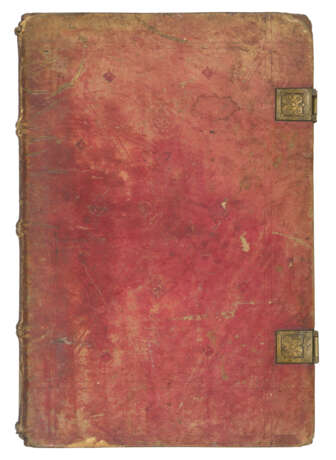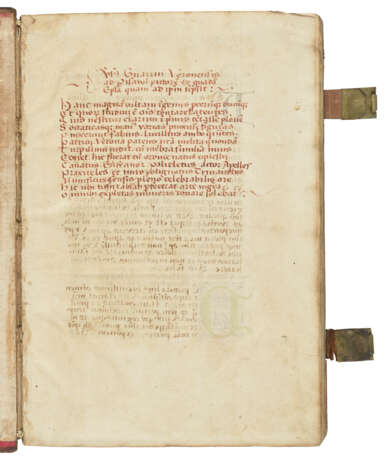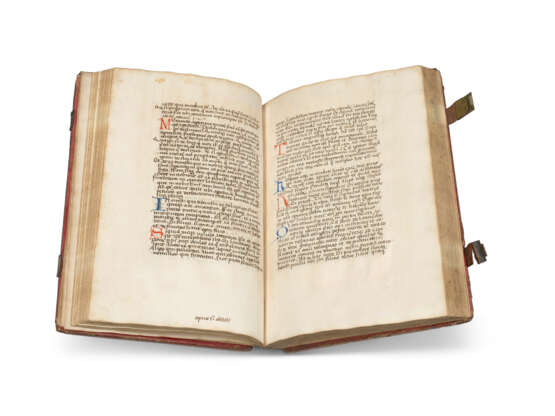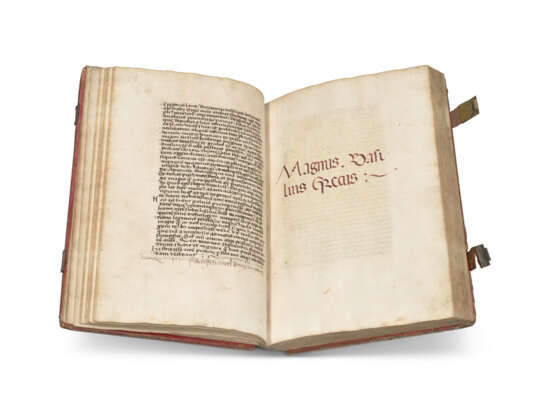ID 1349682
Lot 16 | Sammelband of classical, philosophical, literary and patristic texts
Estimate value
£ 18 000 – 25 000
A sammelband, in Latin, decorated manuscript on paper [Austria or Germany, final quarter 15th century]
An eclectic collection of texts testifying to humanist concerns with the translation of works, both religious and secular, and with classical history, literature, political thought, and geography, including Virgil (and medieval Pseudo-Virgilian poetry), Ovid, Cicero, Lactantius, Leonardo Bruni, Seneca, Isocrates, Aristotle, Basil the Great and Pomponius Mela. In its contemporary German binding.
307 x 212mm. 169 leaves, complete, collation: 1-1610, 179 (of 8, i an inserted singleton), 36 lines, ruled space: 273 x 139mm, one initial in green with elaborate red penwork decoration, other initials alternately red and blue, rubrics and titles in red, catchwords and gathering signatures survive, some marginal notes in two different early hands (minor wormholing in the gutter of opening gatherings, some browning and thumbing, some light dampstains, marginal tear to f.1, marginal spot to f.143, else in good condition with wide margins). Bound in contemporary blind-tooled red-dyed doeskin with fleur-de-lys stamps over unbevelled oak boards, two contemporary brass clasps and catches with quatrefoil flowers (scuffed and rubbed, one leather strap restored, one detached). In a fitted red morocco box.
Provenance:
(1) The watermark on the front pastedown is Piccard 5, Abtlg. 5, Nr. 281, localisable to Vienna, c.1451. The watermarks within the manuscript text are similar to Piccard 16, Abtlg. 4, Nr. 1175, from Stuttgart, c.1460 and DE4200-Donaueschingen58_259, localisable to Vienna, c.1430s-1452. This Germanic origin is consistent with the binding and script, even though the apparently unique rubric on f.124, introducing the ‘Vitia Regnorum’ indicates that the author had been to Spain.
(2) William Ewart Gladstone, Prime Minister (1809-1898): Hawarden Castle library label, MM I 12.
Content: Dedication to Pisanello by Guarino da Verona f.1; Leon Battista Alberti, De Pictura, Books I-III, with dedication to Ludovico Gonzaga, ff.1v-30; title-leaf f.31; Letter of Basil the Great to Gregory Nazianzen, ‘De vita solitaria’, translated into Latin by ‘Ambrosium monachum florentinum’ ff.32-36; ‘Libellus expositionum dictionum Grecarum in prologis S. Hieronymi’ ff.36v-45; ‘Sequitur aliqua notabilia bona’, beginning ‘Quadriforme enim’, ff.45v-46; Epitectus, Enchiridion, in the translation of Niccolò Perotti, with dedication to Pope Nicholas V, and prefatory text, the main text beginning on f.50: ‘Horum quae sunt’, ff.46v-60; Plutarch, De Fortuna Romanorum, in the translation of Niccolò Perotti, with prologue ff.60v-70; Cicero, Somnium Scipionis (excerpt), ff.70-74; Isocrates, Ad Nicoclem, in the translation of Bernardo Giustiniani, with dedication to Ludovico Gonzaga, the main text beginning on f.74v: ‘Consuevere plerique o Nicocles’ and ending with the epistle from Ludovico Gonzaga to Giustiniani ff.74-82; Pseudo-Virgil (attributable to Ausonius), De bono viro, beginning ‘Vir bonus’, ff.82-82v; Pseudo-Virgil (attributable to Ausonius), Rosae, beginning ‘Ver erat’ ff.82v-83; Pseudo-Virgilian verse: ‘Pastor arator eques pavi colui superavi’, f.83; Pseudo-Vincent of Beauvais, the legend of Pallas’ tomb, beginning ‘Narrat Vincentius in speculo historiali’, followed by Virgil’s Suetonian epitaph ‘Mantua me genuit, Calabri rapuere. Tenet nunc Parthenope cecini pascua rura duces’, f.83v; Aelius Donatus, Vita Virgilii, beginning ‘Publius Virgilius Maro Mantuanus parentibus modicis fuit’ ff.83v-91v; Lactantius, De ortu fenicis, beginning ‘Est locus in primus felix oriente remotus’ ff.92-94; Ovid, Amores 3.4, beginning ‘Dure vir imposito tenere custode puelle’ and 2.15, beginning ‘Annule formose digitum vincture puelle’ ff.94-95; Pseudo-Aristotle, ‘Epistola ad Alexandrum’ ff.95v-107; Andreas Contrarius, letter to Pius II, beginning ‘Etsi quanti ego te’ ff.107-116v; Leonardo Bruni, letter to Antonio Pisano, beginning ‘Rem supervacuam’ ff.117-118; Leonardo Bruni, Novella de Tancredo, Bruni’s translation from Boccaccio’s Decameron IV.1, beginning ‘Tancredus princeps’ ff.118-123; ‘Destructiones et Vitia Regnorum’, characteristics of various races, apparently taken first-hand from the Franciscan monk Fr. Angelo at Sagunto: ‘Que sequuntur habui in Regno Castilie a fratre Angelo ordinis minorum apud civitatem Saguncias’, the text also known as ‘De vitiis gentium’ or ‘De proprietatibus gentibus’, beginning ‘Iudeorum Invidia / Persorum perfidia . Egyptorum astutia […]’ f.124; Pseudo-Aristotle, ‘De regimine politico’, beginning ‘Urbis qui Rector fueris duodena nato’, f.124; Ovid, verses from Amores 1, f.124v; Letters of Paul and Seneca ff.124v-127; ‘Notae’ on poverty f.127v; Sextus Rufus, ‘Descriptio Urbis Romane’, beginning ‘Regio prima porta Capena’, ff.128-130v; Pompeius Mela, De situ orbis, ff.131-169.
This sammelband is a testament to the centrality of Italian humanist concerns – artistic, literary, religious and geopolitical – north of the Alps in the second half of the 15th century. It opens with Guarino da Verona’s epistle to Pisanello and follows with Alberti’s famous treatise De Pictura, dedicated to Ludovico Gonzaga, and especially famous for being the first treatise to articulate the workings of linear perspective, the invention of which was attributed to Filippo Brunelleschi. De Pictura was important to artists such as Ghiberti, Fra Angelico and Veneziano, as well as Leonardo da Vinci. The manuscript contains translations of classical authors – Epictetus, Isocrates, Plutarch – by the prominent humanists Niccolò Perotti and Bernardo Giustiniani, as well as a whole section on Virgil, with popular pseudo-Virgilian verse, a legend about Pallas’ tomb, and Aelius Donatus’ ‘Life of Virgil’. There is Leonardo Bruni’s translation of Boccaccio, and passages of a political nature used for the education of princes, including the Pseudo-Aristotelian letters to Alexander, and the verses on political rule ‘De regimine politico’. Particularly interesting is the list of vices relating to various races on f.124: the concept of the innate character of each gens was popular in the Middle Ages, and apparently the present example originated in Spain in the late 9th century. The first-person rubric here, which describes how the author obtained this tract from a Franciscan monk in Spain, seems unique to our manuscript. The sammelband ends with two geographical pieces: a description of the city of Rome, here attributed to Sextus Rufus, and the Roman geographer Pomponius Mela’s hugely influential treatise De situ orbis – the only formal treatise on the subject in Classical Latin.
| Place of origin: | Western Europe, Germany, Europe |
|---|---|
| Auction house category: | Medieval & renaissance manuscripts, Books and manuscripts |
| Place of origin: | Western Europe, Germany, Europe |
|---|---|
| Auction house category: | Medieval & renaissance manuscripts, Books and manuscripts |
| Address of auction |
CHRISTIE'S 8 King Street, St. James's SW1Y 6QT London United Kingdom | |
|---|---|---|
| Preview |
| |
| Phone | +44 (0)20 7839 9060 | |
| Buyer Premium | see on Website | |
| Conditions of purchase | Conditions of purchase |
